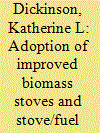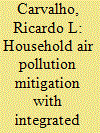|
|
|
Sort Order |
|
|
|
Items / Page
|
|
|
|
|
|
|
| Srl | Item |
| 1 |
ID:
168324


|
|
|
|
|
| Summary/Abstract |
In order to support transitions away from open-fire cooking and toward cleaner household energy systems, a better understanding of users’ technology adoption patterns and preferences is needed. This paper highlights key factors influencing use of two types of biomass-burning stoves provided through the REACCTING (Research on Emissions, Air quality, Climate, and Cooking Technology in Northern Ghana) randomized intervention study. We examine traditional and improved stove use over a two year follow up period, finding that the more basic rocket stove was used at a higher rate than the higher-tech gasifier stove. While stove use patterns varied by stove group, region, primary cook occupation, and socioeconomic status, use of traditional stoves remained high across most groups. Users perceived that improved stoves were less suitable for cooking a staple dish, Tuo Zaafi (TZ), and technical problems (e.g., battery failures with the gasifier stove) also limited the effectiveness of the intervention. Moving forward, household energy policies should prioritize a range of technologies that have potential to meet local needs while delivering meaningful health and/or environmental benefits, recognizing that stove and fuel “stacking” is likely to persist. A greater focus on markets and enabling environments is needed to support sustainable and scalable energy transitions.
|
|
|
|
|
|
|
|
|
|
|
|
|
|
|
|
| 2 |
ID:
150911


|
|
|
|
|
| Summary/Abstract |
A majority of grid-connected households in South Africa use electricity for cooking and heating tasks. This thermal intensive use of electricity has a high load factor and is a contributory factor of electricity demand outstripping supply at peak demand periods. The government has promoted liquefied petroleum gas (LPG) as an alternative thermal energy source for household cooking and heating. This study evaluates the long-term successes, challenges and social impacts of an LPG intervention project that was piloted in Atteridgeville Township, a typical low-income suburb. The data was gathered through one-on-one household interviews with a sample of the beneficiaries. The results indicate that seven years after the LPG intervention, about 70% of the beneficiaries continue to use LPG and report that the intervention has improved their welfare. Fast cooking is cited as the key tangible benefit of LPG technology in households, followed by saving on electricity bills. The project would have achieved more success through better community engagement, including strict beneficiary selection criteria; a long-term LPG distribution and maintenance plan; and inclusion of recurring monthly LPG subsidies for indigent households. The study discusses the subset of factors necessary for successful rollouts of similar energy projects.
|
|
|
|
|
|
|
|
|
|
|
|
|
|
|
|
| 3 |
ID:
166720


|
|
|
|
|
| Summary/Abstract |
Traditional cooking is today's largest global environmental health risk. Over 640 million people in Africa are expected to rely on biomass for cooking by 2040. In Kenya, cooking inefficiently with wood and charcoal persists as a cause of deforestation and household air pollution. This research analyses the effects of four biomass cookstove strategies on reducing air pollutant emissions in Kisumu County between 2015 and 2035 using the Long-Range Energy Alternatives Planning system. The Business as Usual scenario (BAU) was developed considering the historical trends in household energy use. Energy transition scenarios to Improved Cookstoves (ICS), Pellet Gasifier Stoves (PGS) and Biogas Stoves (BGS) were applied to examine the impact of these systems on energy savings and air pollution mitigation. An integrated scenario (INT) was evaluated as a mix of the ICS, PGS and BGS. The highest energy savings, in relation to the BAU, are achieved in the BGS (30.9%), followed by the INT (23.5%), PGS (19.4%) and ICS (9.2%). The BGS offers the highest reduction in the GHG (37.6%), CH4 (94.3%), NMVOCs (85.0%), CO (97.4%), PM2.5 (64.7%) and BC (48.4%) emissions, and the PGS the highest reduction in the N2O (83.0%) and NOx (90.7%) emissions, in relation to the BAU.
|
|
|
|
|
|
|
|
|
|
|
|
|
|
|
|
| 4 |
ID:
150456


|
|
|
|
|
| Summary/Abstract |
Malawi has set a target of adoption of two million improved cookstoves (ICS) by 2020. Meeting this objective requires knowledge about determinants of adoption, particularly in rural areas where the cost of traditional cooking technologies and fuels are non-monetary, and where people have limited capacity to purchase an ICS. We conducted a discrete choice experiment with 383 households in rural Malawi asking them if they would chose a locally made ICS or a package of sugar and salt of roughly equal value. Six months later, we assessed adoption and stove use patterns. Sixty-six percent of households chose the ICS. We find that having a larger share of crop residues in household fuel supply, awareness of the environmental impacts of woodfuel reliance, time the primary cook devotes to collecting fuelwood, and peer effects at the village-level increase the odds of choosing the ICS. Having a large labor supply for fuelwood collection and experience with a non-traditional cooking technology decreased the odds of choosing the ICS. In a rapid assessment six months after stoves were distributed, we found 80% of households were still using the ICS, but not exclusively. Our findings suggest considerable potential for wide-scale adoption of low cost ICS in Malawi.
|
|
|
|
|
|
|
|
|
|
|
|
|
|
|
|
|
|
|
|
|